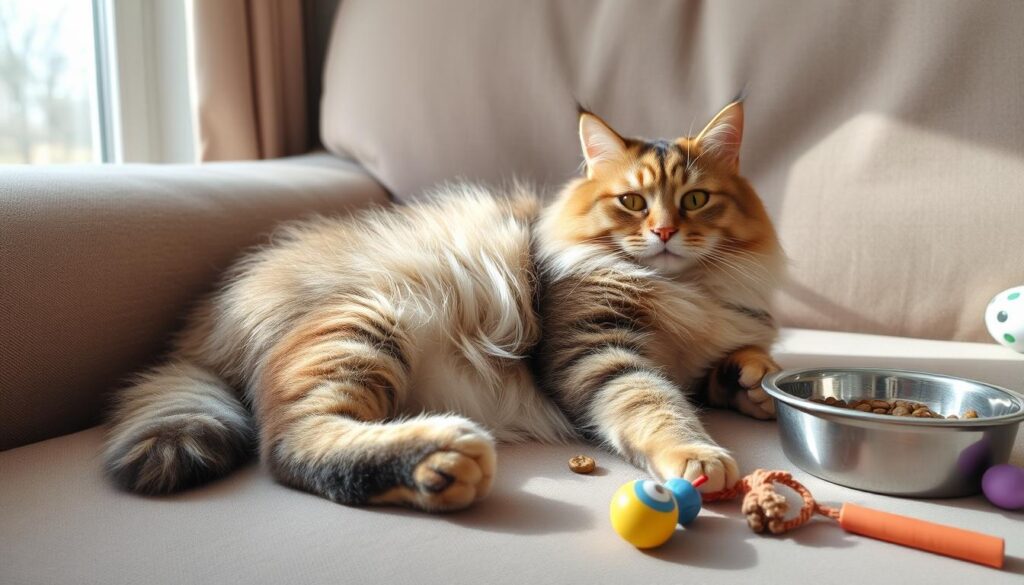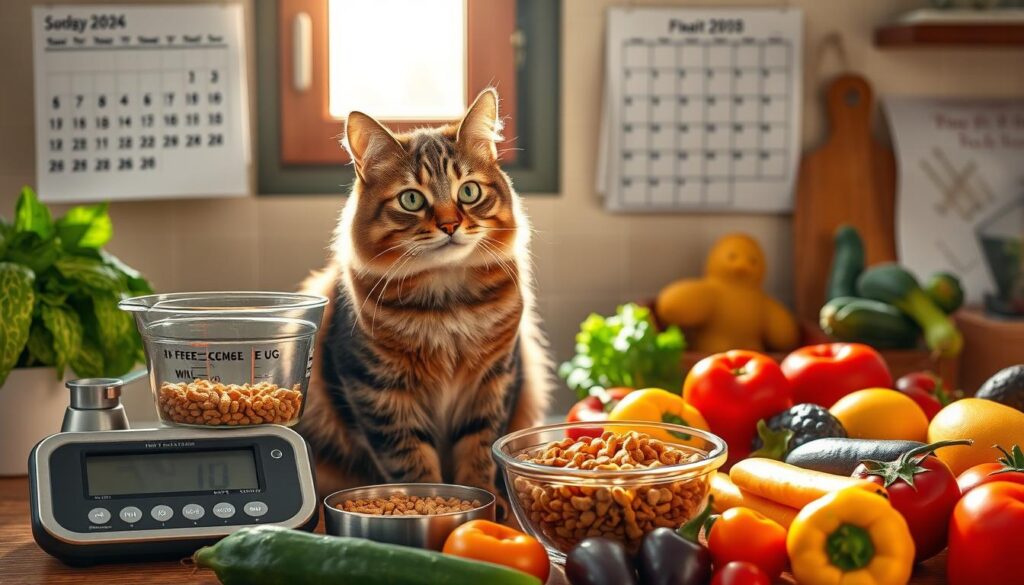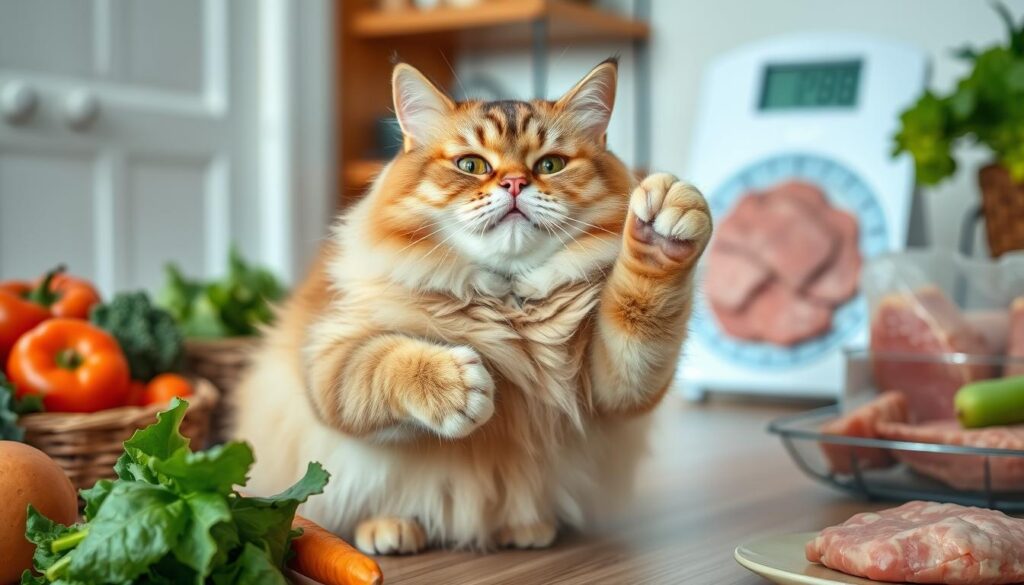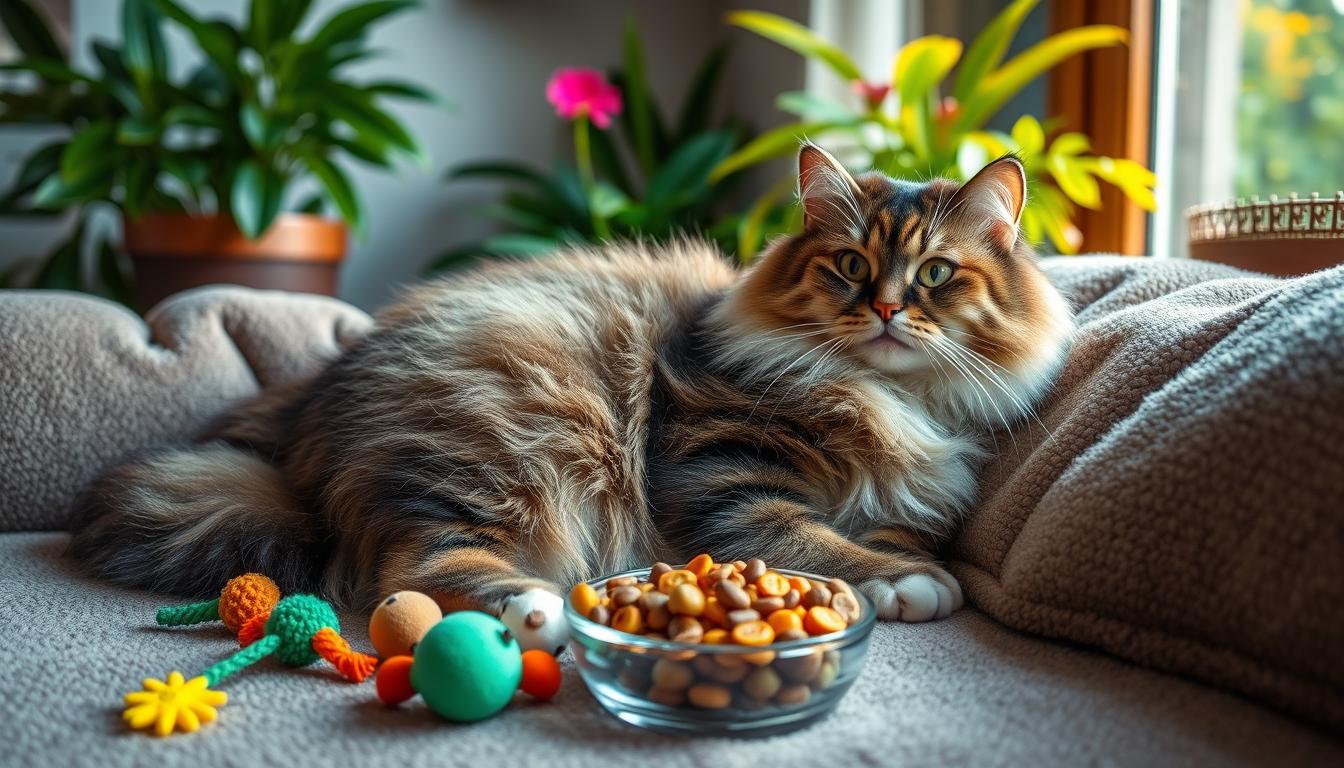As pet owners, we often overlook our feline friends’ weight. But, did you know over 50% of cats in the US are overweight or obese? This is a big problem that needs our attention to keep our cats healthy and happy.
Table of Contents
Understanding Cat Obesity
Feline obesity is a big problem for many pet owners. Studies show that up to 60% of cats in the U.S. are too heavy. It’s important to know about feline obesity to help our cats stay healthy.
Definition of Obesity in Cats
Obesity in cats means they have too much body fat. This can hurt their health and happiness. If a cat is 20% or more overweight, it’s considered obese.
Common Causes of Weight Gain
- Overfeeding: Giving cats too much food can make them gain weight.
- Lack of exercise: Cats need to move to stay healthy and not get too heavy.
- Certain medical conditions: Some health issues, like thyroid problems, can make cats gain weight.
Health Risks Associated with Obesity
Overweight cats face many health dangers. These include:
- Diabetes: Too much fat can make cats resistant to insulin and lead to diabetes.
- Arthritis: Extra weight can hurt a cat’s joints and cause arthritis.
- Cardiovascular disease: Obesity can raise blood pressure and harm the heart.
- Reduced lifespan: Obese cats often live shorter lives than healthy ones.
Knowing about feline obesity helps us keep our cats healthy. This way, they can live long, happy lives.
Recognizing the Signs of Overweight Cats
Spotting an overweight cat is about watching for signs in their actions and looks. It’s key to catch these signs early. This helps your cat stay healthy and happy.
Behavioral Indicators
Overweight cats might act differently. They might:
- Move less and not want to play or exercise
- Have trouble grooming, leading to matted fur or skin issues
- Want food all the time, beg, act aggressively during meals, and eat fast
- Have trouble keeping cool, pant a lot, seek cool spots, and groom less
Physical Signs to Look For
Overweight cats also show physical signs. Look for:
- A big belly and no waistline when seen from above
- Can’t feel the cat’s ribs and spine because of fat
- A fuller face and less clear cheeks and neck
- Have trouble jumping, climbing, and moving, and might lean on one leg
Seeing these signs is important for your cat’s health. Catching the problem early lets you and your vet create a weight loss plan. This helps your cat live a healthier life.

Assessing Your Cat’s Weight
It’s important to check your cat’s weight often. This helps with cat weight loss and keeps them healthy. You can weigh your cat at home and check their body condition. This helps you make good pet diet plans.
How to Weigh Your Cat at Home
Weighing your cat at home is easy. First, put a flat surface on your bathroom scale. Then, carefully put your cat on it and write down the number. Remember to subtract the surface’s weight to find your cat’s real weight.
It’s best to weigh your cat every week. This lets you see if their weight is changing. You can then adjust their food and exercise as needed.
Understanding Body Condition Scoring
Body condition scoring lets you see how your cat looks and feels. It’s a number from 1 to 9. A score of 5 means they’re just right, with a waist and ribs you can feel but not see too much.
Cats with scores of 7 or higher are too heavy. Those with scores of 4 or lower are too light. Checking this score often helps you see if your cat needs to eat less or more.
| Body Condition Score | Description |
|---|---|
| 1-3 | Underweight |
| 4 | Ideal |
| 5-6 | Healthy |
| 7-8 | Overweight |
| 9 | Obese |
By weighing and checking body condition often, you learn a lot about your cat’s health. This helps you make the best pet diet plans for them. Checking often is key to keeping your cat at a healthy weight.
Importance of Nutrition in Weight Management
Good nutrition is key for keeping your cat at a healthy weight. It’s important to pick the right cat food. This depends on your cat’s age, how active they are, and their health.
Knowing how many calories your cat needs is very important. This helps you control how much food they get. A vet can help make a diet plan just for your cat.
Choosing the Right Cat Food
The food you choose is very important for your cat’s weight. Look for foods high in protein and low in carbs. This helps keep your cat at a healthy weight.
Stay away from foods with too many fillers. They can make your cat gain weight. Talk to your vet to find the best food for your cat.
Understanding Caloric Needs
It’s important to watch how many calories your cat eats. The right amount depends on their age, how active they are, and their health. Cat calorie monitoring helps make sure they get the right amount of food.
Your vet can help figure out what your cat needs. They can guide you on veterinary nutrition.
Proper nutrition is the foundation of a healthy weight management plan for cats.
By picking the right food and knowing your cat’s calorie needs, you can help them stay at a healthy weight. This is good for their overall health and happiness.
Developing a Weight Loss Plan
Helping your cat lose weight needs a good plan. Pet diet plans must have realistic goals. Work with your vet to make a plan that fits your cat’s age, health, and life.
Setting Realistic Weight Loss Goals
A good weight loss plan is slow and steady. Aim for 2-4% of your cat’s weight loss each month. Fast weight loss is bad, so set goals that keep your cat healthy.
Collaborating with a Veterinarian
Your veterinary nutrition expert is very helpful. They can pick the right food and caloric intake for your cat. They also check on your cat’s progress and adjust the plan as needed.
Working with your vet is important for your cat’s weight loss. Their help and your effort can make your cat healthier and happier.
Creating a Feeding Schedule
It’s important to have a regular feeding schedule for your cat. This helps keep their weight healthy. By controlling how much and how often they eat, you can help them stay fit.
How Often Should You Feed Your Cat?
Vets say cats should eat small meals all day, not just when they want. This stops them from eating too much. Try feeding your cat three to four times a day, at the same times.
Portion Control Strategies
- Use a measuring cup to make sure you’re giving the right amount of food.
- Don’t let your cat eat all the time, as this can make them gain weight.
- Try a special low-calorie cat food made for weight control.
- Talk to your vet to figure out how many calories your cat needs each day.
Having a set feeding schedule and controlling portions helps your cat stay at a good weight. Always check with your vet to make sure your cat is getting the right food and staying healthy.

“Maintaining a consistent feeding routine and portion control is essential for helping an overweight cat reach a healthy weight. Work closely with your veterinarian to find the right approach for your feline friend.”
Incorporating Exercise into Your Cat’s Routine
Keeping your cat at a healthy weight is very important. Regular exercise is a big part of that. Playtime and fun toys can help your cat stay active and fit.
Fun Ways to Encourage Activity
There are many ways to get your cat moving. Try using catnip dinosaur toys to make them run and play. These toys are good for their mind and body.
Catnip in these toys can also calm them down. Chewing on these toys is good for their teeth.
- Catnip dinosaur toys stimulate natural hunting instincts in cats.
- Interactive play with catnip dinosaur toys promotes both mental agility and physical activity.
- Catnip has natural calming properties that help alleviate stress in cats.
- Engagement with catnip dinosaur toys encourages creativity and exploration in cats.
- Chewing and biting on catnip dinosaur toys can contribute to a cat’s dental health.
The Benefits of Interactive Toys
It’s important to choose catnip-filled cat toys that are safe. Watching your cat play can keep them safe too. Changing toys often keeps playtime exciting and fun.
- Catnip filled cat toys are designed to stimulate a cat’s senses and provide hours of amusement.
- Catnip can help reduce stress and anxiety in cats, adding an extra element of excitement to playtime.
- Playing with catnip filled toys can help reduce stress and anxiety in cats.
- Catnip toys can encourage cats to be more active and engage in playtime.
- Regular play with catnip toys can help with weight management and overall fitness for cats.
Adding exercise for cats and cat fitness routines to their day is great. It helps them stay healthy and happy. With the right toys and a bit of creativity, exercise can be fun for both you and your cat.
Monitoring Progress and Adjusting Plans
Watching your cat’s weight closely is key for cat weight loss success. Regular weigh-ins and body checks are important. They help you see if your cat’s diet and exercise are working.
Keeping Track of Weight Changes
Check your cat’s weight every week or two. Keep a record of the weights. Look for small changes, as they show if the plan is working.
Signs It’s Time to Change the Approach
- Lack of weight loss despite following the plan
- Significant weight fluctuations from week to week
- Behavioral changes like increased begging or decreased activity
- Concerns about your cat’s overall health and well-being
If you see these signs, it’s time to talk to your vet. They can help adjust the cat weight loss plan. This ensures your cat stays healthy and safe.

Watching your cat’s progress closely is crucial. Being quick to notice and act on any issues is key. This way, you can help your cat stay at a healthy weight, improving their life.
Managing Cat Behavior During Weight Management
Starting a weight loss journey with your cat can be tough but rewarding. It can also change how they behave. It’s important to handle these changes well to help your cat lose weight and stay healthy.
Tips for Reducing Stress
Weight loss can stress cats out. They might feel uneasy about new diets and routines. To ease stress, keep a regular daily schedule and make sure they have a comfy place to relax.
Give them lots of love and playtime. Cats like things to stay the same. Try not to change their usual times for eating, sleeping, or playing with you.
Dealing with Begging and Food Requests
Cats might beg for food when they’re trying to lose weight. They might meow or paw at you to get more treats. To stop this, feed them on a set schedule and reward good behavior, not extra food.
By using stress-reducing methods and managing food requests, your cat can adjust to their new life. Remember, being consistent, patient, and positive is key to helping them.
“Achieving a healthy weight for your cat requires a multifaceted approach, including addressing their behavioral needs alongside the physical aspects of weight management.”
Understanding the Role of Treats
Treats are important for a cat’s health. But, they can make a cat gain weight if given too much. It’s key to know how treats affect weight and how to use them right.
Healthier Treat Options
Choosing the right treats is key for a cat’s weight plan. Look for treats that are low in calories but full of nutrients. Some good options are:
- Freeze-dried meat or fish treats
- Low-calorie, high-protein snacks
- Catnip-infused toys that encourage physical activity
How to Use Treats Without Overindulging
To keep treats from ruining your cat’s weight plan, count them in the daily calorie total. Give fewer treats and make sure they’re less than 10% of your cat’s daily calories. Use treats as rewards for play or training to keep your cat active and happy.
By picking healthier treats and using them wisely, you can help your cat stay at a healthy weight. They can still enjoy treats without harming their health.
| Statistic | Value |
|---|---|
| Cat’s weight at one-year checkup | 16 pounds |
| Cat’s weight after successful weight loss | 9 pounds |
| Cat’s weight after feeding schedule adjustment | 11 pounds |
| Recommended target weight | Around 9 pounds |

Overweight cats face many health problems like diabetes and heart disease. It’s vital to work with a vet to find the best diet and treat plan for your cat.
“Rapid weight loss in cats can lead to fatty liver syndrome, also known as hepatic lipidosis, so it’s crucial to find the right balance with the guidance of a professional.”
Long-Term Weight Management Strategies
Keeping your cat at a healthy weight is a long-term job. It needs commitment and a plan that lasts. Regular exercise, eating the right amount, and seeing the vet often are key. These steps help your cat stay in top shape.
Maintaining a Healthy Lifestyle
To keep your cat’s weight healthy, try these tips:
- Play with your cat often. Use toys, scratching posts, and cat towers.
- Feed your cat the same amount every day. Give them the right size of food.
- Don’t give too many treats. Choose healthy ones that help with weight.
- Watch how much your cat eats. Make sure they get the right amount of food and calories.
Regular Vet Check-Ups
Seeing the vet often is key for your cat’s health. At these visits, the vet can:
- Check your cat’s weight and body shape. Make sure they’re healthy.
- Give advice on food and exercise. It’s based on your cat’s needs.
- Look for health problems that might affect weight.
- Help you manage your cat’s weight. They’ll give you tips and support.
By using these strategies and talking to your vet, you can help your cat stay healthy. This reduces the risks of feline obesity and keeps them happy and well.
Seeking Professional Help
For overweight cats, a special weight loss plan is key. Sometimes, you need a vet’s help to make sure it’s safe and works well.
When to Consult a Veterinarian
If your cat is very overweight or has health issues, see a vet. They can check your cat, find health problems, and make a weight loss plan just for them.
Possible Referral to a Pet Nutritionist
Your vet might suggest talking to a pet nutritionist. These experts know a lot about cat food and how to help them lose weight. They can make a special diet plan and check on your cat’s progress.
>> Brand New! Cat Language How to Finally Speak Cat! <<

